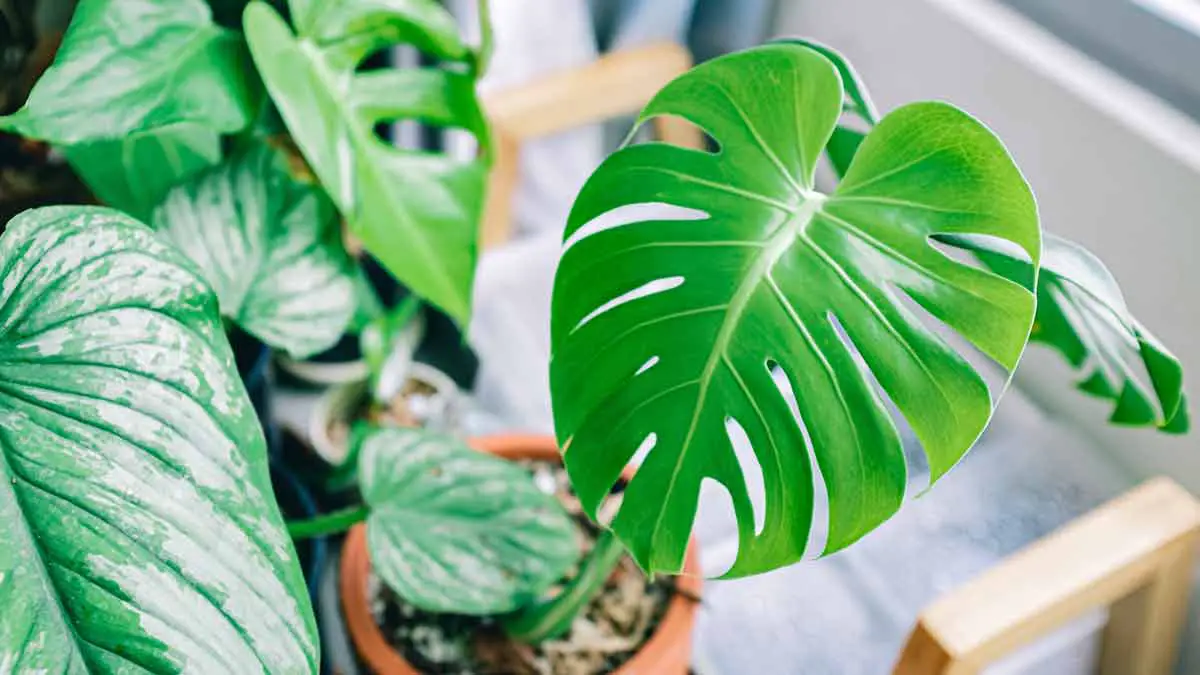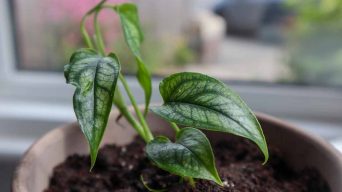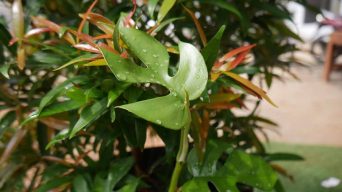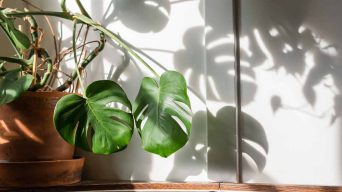To properly care for indoor Monstera plants, they need watering every 1-2 weeks, medium to bright indirect light, and temperatures of 65-75°F. They require well-drained, slightly acidic soil and should be kept out of direct sunlight. Adequate drainage is important to prevent soil from becoming too soggy.
Are you looking for a statement houseplant that will bring your interior to life? Monstera is a perfect choice.
With its lush, tropical foliage and trailing vines, this beautiful plant can be a stunning addition to any home or office.
But in order to keep it healthy, happy, and thriving indoors, there are certain things you need to know about monstera indoor care.
In this complete guide, we’ll teach you everything from how much light it needs and when to water it to how to prune it and where to place it.
Whether you’re a beginner or an experienced indoor gardener, this guide will help you master monstera indoor care.
Understanding Monstera Plants
Monstera plants, also known as Swiss cheese plants, are a popular houseplant that has been steadily gaining popularity among plant lovers in recent years.
These plants are known for their unique and distinctive appearance, with their large leaves that have holes and splits, giving them the appearance of Swiss cheese.
Characteristics of Monstera Plants
The monstera plant belongs to the Araceae family and is native to the tropical rainforests of Central and South America.
It is an evergreen vine that can grow up to 20 meters in its natural habitat, but when grown indoors, it usually grows up to 2 meters tall.
Monstera plants have large, glossy green leaves that can grow up to 90 centimeters long and 75 centimeters wide.
The leaves have an unusual shape, with deep splits and holes that are known as fenestrations. These holes help the plant to absorb more light and nutrients.
Popular Varieties of Monstera Plants
There are several popular varieties of monstera plants, each with its unique characteristics.
One of the most common varieties is the Monstera deliciosa plant, which is also known as the Swiss cheese plant. This variety has large, glossy green leaves that can grow up to 90 centimeters in length and is deeply split with holes.
The Monstera adansonii, also known as the Swiss cheese vine, is another popular variety. It has smaller leaves with more pronounced holes, giving it a delicate appearance.
The Monstera obliqua, also known as the Swiss cheese plant’s rarest variety, has the most pronounced holes, giving the leaves a delicate, lace-like appearance.
Ideal Growing Conditions for Monstera Plants
These plants prefer bright, indirect sunlight, which means that they should be placed near a window but not in direct sunlight.
They can also tolerate low light conditions but will grow more slowly in such conditions. Monstera plants prefer warm and humid environments and will not tolerate cold temperatures or drafts.
They prefer soil that is well-draining and moist but not waterlogged. It is essential to allow the soil to dry slightly between waterings to prevent root rot.
These plants can be fertilized once a month during the growing season, and it is essential to use a balanced fertilizer.
Watering Indoor Monstera Plants
If you’re the proud owner of a beautiful Monstera plant, you know how important it is to keep it happy and healthy.
One of the most critical factors in keeping your Monstera thriving is providing it with the right amount of water.
However, watering indoor Monstera plants can be tricky, and there are several things to keep in mind to ensure your plant stays healthy and vibrant.
How Often to Water a Monstera Plant?
First and foremost, let’s talk about how often you should water your Monstera plant.
Generally speaking, Monstera plants prefer well-draining soil that is kept consistently moist but not waterlogged. This means you should water your plant every one to two weeks, depending on how quickly the soil dries out.
The Importance of Proper Drainage and Adequate Soil Moisture
Proper drainage is essential when it comes to watering your Monstera plant.
If your plant is sitting in a pot without drainage holes, the soil will become waterlogged and could lead to root rot.
To ensure your Monstera has proper drainage, make sure your pot has drainage holes and use a well-draining potting mix.
In addition to drainage, you need to ensure that the soil stays adequately moist.
The key is to find a balance between overwatering and underwatering.
Overwatering can lead to root rot, while underwatering can cause the plant to become stressed and wilted. It’s important to check the soil’s moisture level regularly to determine when it’s time to water again.
Signs of Overwatering and Underwatering
To ensure your Monstera stays healthy, you need to pay attention to signs of overwatering and underwatering.
Overwatered Monstera plants often develop yellowing leaves, a foul odor, and mushy stems.
Underwatered Monstera plants, on the other hand, will have dry, brown leaves and may become brittle and prone to breaking.
Tips for Watering a Monstera Plant Correctly
Now that you know how often to water your Monstera plant and the signs of over and underwatering, let’s discuss some tips for watering your plant correctly:
- Use room temperature water: Water your Monstera plant with room temperature water to avoid shocking the roots.
- Water thoroughly: Water your plant thoroughly, ensuring that the water reaches the roots. Let the excess water drain out of the pot.
- Use a moisture meter: If you’re unsure whether it’s time to water your plant, consider investing in a moisture meter. This tool will help you determine the moisture level of the soil.
- Adjust watering frequency based on the season: In the summer months, you may need to water your Monstera more frequently than in the winter months.
- Keep an eye on humidity: Monstera plants prefer a humid environment, so consider using a humidifier or misting the leaves occasionally.
Humidity Requirements
One crucial aspect of caring for Monstera plants is humidity.
But why is humidity important for Monstera plants?
Well, these tropical beauties hail from the rainforests of Central and South America, where humidity levels can reach up to 90 percent.
As such, Monstera plants have adapted to thrive in a high-humidity environment. In their native habitat, the dense forest canopy provides shade and traps moisture, creating a humid microclimate that these plants love.
Now, when you bring a Monstera plant into your home, you’re essentially asking it to adapt to an entirely different environment.
The air inside your home is likely to be drier than the air in the rainforest, which can cause problems for your plant.
Without enough moisture in the air, your Monstera plant can become dehydrated, which can lead to leaf browning, leaf drop, and stunted growth.
Recommended Humidity Levels for Monstera Plants
So, what are the recommended humidity levels for Monstera plants? Ideally, you want to aim for a relative humidity level of around 60 to 80 percent.
This may sound high, but it’s important to remember that Monstera plants need a lot of moisture to thrive.
If the air in your home is too dry, you may need to supplement the humidity levels with some additional measures.
Tips for Maintaining the Right Level of Humidity for Monstera Plants
One effective way to increase humidity levels around your Monstera plant is to use a humidifier.
A humidifier can release moisture into the air, creating a humid microclimate around your plant.
You can also try placing a tray of water near your plant or misting it regularly with a spray bottle.
Just be careful not to overwater your plant in the process, as too much water can lead to root rot.
Another tip for maintaining the right level of humidity for your Monstera plant is to group it with other plants.
As plants release moisture into the air through a process called transpiration, grouping your Monstera plant with other leafy plants can help to create a more humid environment.
Plus, it’s a great way to create a lush and jungle-like atmosphere in your home!
If you’re struggling to maintain the right level of humidity for your Monstera plant, there are some signs to look out for that may indicate a problem.
If your Monstera’s leaves are turning brown or crispy at the edges, this could be a sign that the air is too dry.
Conversely, if the Monstera leaves are yellowing or becoming soft, this could be a sign of overwatering, which can also be a problem.
Light Requirements
Monstera plants, with their iconic split leaves, are a popular choice for indoor plants.
They are not only aesthetically pleasing but also relatively easy to care for.
However, one aspect of taking care of your monstera plant that can often be overlooked is providing it with adequate light.
First and foremost, it’s important to understand the ideal amount of sunlight for your monstera plant.
These plants thrive in medium to bright indirect light. This means that they need enough light to grow but not direct sunlight.
Direct sunlight can be harmful to monstera plants, as it can cause leaf burn and damage the delicate leaves.
So, if you want your monstera plant to flourish, be sure to avoid overexposure to direct sunlight.
How To Provide Adequate Light for a Monstera Plant
So, how do you provide adequate light for your monstera plant without overexposing it to direct sunlight?
One solution is to place your plant near a window that gets bright, indirect light for several hours a day.
You can also use sheer curtains or blinds to filter out any direct sunlight.
Another option is to use artificial light sources, such as grow lights, to supplement natural light.
Signs of Insufficient Light and How to Remedy Them
Now that you know how to provide adequate light for your monstera plant, let’s talk about the signs of insufficient light and how to remedy them.
If your plant isn’t getting enough light, you may notice that its leaves are turning yellow or brown or that it’s not growing as quickly as it should be.
To remedy this, you can try moving your plant to a brighter location or supplementing its natural light with artificial light sources.
But wait, there’s more! Did you know that the amount of light your monstera plant receives can also affect its leaf size and shape?
In low light conditions, monstera plants may develop smaller leaves with fewer splits, while in brighter conditions, they may grow larger leaves with more splits.
So, if you want your monstera plant to have those iconic split leaves, make sure it’s getting enough light!
Providing adequate light for your indoor monstera plant is crucial for its growth and health.
Remember to keep your plant in medium to bright indirect light, avoid overexposure to direct sunlight, and watch for signs of insufficient light.
Temperature and Environment Requirements
If you’re a proud owner of a monstera plant, you may already know that these tropical beauties thrive in warm temperatures.
In fact, the optimal temperature range for monstera plants is between 65 and 75 degrees Fahrenheit.
But what happens when the temperature dips too low or climbs too high? And how can you regulate the temperature to ensure your monstera plant stays healthy and happy? Let’s dive in.
Effects of Temperature Extremes on Monstera Plants
Like most plants, monstera plants can be sensitive to extreme temperatures. If the temperature drops below 50 degrees Fahrenheit or rises above 85 degrees Fahrenheit, your monstera plant may start to show signs of stress.
For example, you may notice the leaves turning yellow, brown, or black, or the plant may stop growing altogether.
When the temperature is too cold, the plant’s metabolism slows down, and it may struggle to absorb nutrients and water from the soil.
On the other hand, when the temperature is too hot, the plant may lose too much water through transpiration, leading to dehydration and wilting.
Tips for Regulating Temperature for a Monstera Plant
So how can you keep the temperature in the optimal range for your monstera plant?
Here are some tips:
- Keep your monstera plant away from drafts: Cold drafts can be particularly harmful to monstera plants, so keep your plant away from windows, doors, and air conditioning vents. If you do need to place your plant near a drafty area, consider using a draft stopper or placing a barrier between the plant and the draft.
- Use a thermometer: To ensure that the temperature stays within the optimal range, use a thermometer to monitor the temperature around your monstera plant. You can also use a hygrometer to monitor the humidity levels, as monstera plants prefer a humid environment.
- Adjust the temperature: If the temperature is too low, you can use a space heater or a heat lamp to raise the temperature around your monstera plant. Similarly, if the temperature is too high, you can use an air conditioner or a fan to cool the room down. Just make sure not to place the heating or cooling source too close to the plant, as this can cause stress.
- Consider the time of day: Monstera plants prefer warmer temperatures during the day and cooler temperatures at night. If possible, try to adjust the temperature accordingly. For example, you can turn down the heat at night or use a programmable thermostat to regulate the temperature automatically.
How to Care an Indoor Monstera Plant from Cold Drafts
As we mentioned earlier, cold drafts can be particularly harmful to monstera plants.
If you live in a drafty home or apartment, it’s essential to take steps to protect your monstera plant from the cold.
Here are some tips:
- Close windows and doors: Make sure to close all windows and doors around your monstera plant, especially during the winter months when temperatures can drop significantly.
- Use insulation: If you have a window or door that lets in a lot of cold air, consider using insulation to seal the gaps. You can use weatherstripping, caulking, or foam insulation to block out the cold.
- Use a plant cover: If your monstera plant is located near a drafty area, you can use a plant cover to protect it from the cold. Plant covers come in various materials, including plastic, fabric, and they can be placed over the plant to create a barrier against the cold air. Just make sure to remove the cover during the day to allow for proper ventilation.
- Move the plant: If you can’t regulate the temperature in a particular area, consider moving your monstera plant to a different location. For example, you can move the plant to a warmer room or a spot that is not exposed to cold drafts.
- Increase humidity: In addition to protecting your monstera plant from cold drafts, you can also increase the humidity around the plant to help it thrive. You can use a humidifier or place a tray of water near the plant to increase the moisture in the air.
Monstera plants thrive in warm temperatures, but they can be sensitive to temperature extremes.
To ensure your monstera plant stays healthy and happy, it’s essential to regulate the temperature and protect it from cold drafts.
Soil Needs
When it comes to soil, Monstera plants require a well-drained and slightly acidic environment. This means that the soil should not be too dense or compact, as this can prevent proper drainage and lead to root rot.
Instead, it is best to use a soil mix that is light and airy, allowing for adequate water flow.
In addition to being well-drained, the soil used for Monstera plants should also be slightly acidic, with a pH range of 5 to 7. This is because Monstera plants are native to the rainforests of Central and South America, where the soil tends to be slightly acidic.
By replicating these conditions in your indoor garden, you can help your Monstera plant to thrive.
When choosing a soil mix for your Monstera plant, it is important to look for products that are specifically designed for indoor plants.
These mixes often contain a blend of peat moss, perlite, and vermiculite, which provide the necessary drainage and acidity levels. Y
ou can also add additional nutrients, such as compost or worm castings, to enrich the soil and provide your Monstera plant with the essential nutrients it needs.
With the right soil mix in place, you can create an ideal environment for your Monstera plant to grow and flourish indoors.
Fertilization Requirements
Fertilizing your monstera plant is essential to keep it healthy and vibrant.
Monstera plants are known for their striking appearance and lush foliage, and proper fertilization can help them reach their full potential.
When to Fertilize a Monstera Plant
Fertilizing a monstera plant can be tricky, as too much fertilizer can harm the plant, while too little can stunt its growth.
In general, it’s best to fertilize your monstera plant during the growing season, which is typically in the spring and summer months.
You can also fertilize your plant during the fall, but it’s important to reduce the amount of fertilizer you use.
How to Fertilize a Monstera Plant
When fertilizing your monstera plant, it’s important to follow the instructions on the fertilizer package carefully.
Generally, you should dilute the fertilizer with water before applying it to the soil.
You can use a watering can or spray bottle to apply the fertilizer to the soil around the base of the plant.
Benefits of Fertilizing a Monstera Plant
Fertilizing your monstera plant has many benefits. It can help promote healthy growth, increase the number of leaves, and improve the plant’s overall appearance.
Fertilizing can also improve the plant’s resistance to disease and pests, which can help it live longer.
Recommended Fertilizers for Monstera Plants
There are many different types of fertilizers available for monstera plants, but it’s important to choose the right one for your specific plant.
One of the best fertilizers for monstera plants is a balanced, water-soluble fertilizer with equal amounts of nitrogen, phosphorus, and potassium.
You can also use a slow-release fertilizer that gradually releases nutrients into the soil over time.
How to Avoid Overfertilizing a Monstera Plant
Overfertilizing your Monstera plant can be harmful, as it can cause the roots to burn and the leaves to turn yellow.
To avoid overfertilizing, it’s important to follow the instructions on the fertilizer package carefully and use the correct amount of fertilizer for your plant.
You should also avoid fertilizing your plant during the winter months when it is not actively growing.
Pruning and Shaping
If you’re a plant enthusiast, you might have heard of the Monstera plant, a popular indoor plant with large, green, and holey leaves. Pruning is an essential aspect of caring for a Monstera plant, as it helps the plant grow better and maintain its shape.
Why Pruning is Important for Indoor Monstera Plants
Pruning is the act of cutting off dead or overgrown parts of a plant to encourage new growth.
When it comes to indoor Monstera plants, pruning is essential to keep the plant healthy and maintain its shape.
Pruning helps to remove any diseased or damaged parts of the plant, improving its overall health. It also encourages new growth, making the plant look fuller and lusher.
Furthermore, pruning helps to prevent the Monstera plant from becoming too leggy. Leggy plants have long, thin stems with fewer leaves, which can make them look unattractive.
By pruning your Monstera plant regularly, you can prevent it from becoming leggy and keep it looking beautiful.
Tools Needed for Pruning
To prune your Monstera plant, you’ll need a few tools, including a pair of sharp scissors or pruning shears, a clean cloth or tissue, and rubbing alcohol.
You’ll use the scissors or pruning shears to cut the stems and leaves, a clean cloth or tissue to wipe the blades of the scissors, and rubbing alcohol to disinfect the blades before and after pruning.
Steps for Pruning an Indoor Monstera Plant
Monstera plants are fairly easy to prune. Follow these steps for successful pruning:
Step 1: Inspect Your Plant
Before you start pruning, inspect your Monstera plant to determine which parts need to be pruned.
Look for any dead, damaged, or diseased leaves or stems.
Also, check for any leggy stems that need to be cut back.
Step 2: Prepare Your Tools
Next, prepare your tools by wiping the blades of the scissors or pruning shears with a clean cloth or tissue.
Then, disinfect the blades by rubbing them with rubbing alcohol.
Step 3: Prune Your Monstera Plant
Now it’s time to start pruning your Monstera plant.
Begin by cutting off any dead, damaged, or diseased leaves or stems. Use the scissors or pruning shears to make a clean cut close to the base of the stem.
If you’re cutting off a leggy stem, cut it back to a point just above a leaf node. A leaf node is a small bump on the stem where a leaf grows.
Step 4: Clean Your Tools
After you’ve finished pruning your Monstera plant, wipe the blades of your scissors or pruning shears again with a clean cloth or tissue.
Then, disinfect the blades with rubbing alcohol to prevent the spread of disease.
Tips for Shaping a Monstera Plant through Pruning
Pruning can also be used to shape your Monstera plant.
Here are some tips to help you shape your plant:
Tip 1: Use Your Fingers to Guide the Shape
As you prune your Monstera plant, use your fingers to guide the shape.
You can gently bend and shape the stems to create the desired shape. This will help you achieve a more natural look.
Tip 2: Prune More at the Top
To create a fuller look, prune more at the top of the plant than at the bottom.
This will encourage new growth at the top and create a more balanced look.
Tip 3: Prune Regularly
Pruning should be done regularly to prevent your Monstera plant from becoming overgrown or leggy.
It’s a good idea to prune your plant every few months or as needed, depending on how fast it’s growing.
Tip 4: Avoid Over-pruning
While pruning is essential, avoiding over-pruning your Monstera plant is important.
Over-pruning can cause stress to the plant, which can affect its growth and overall health.
So, be sure only to prune what’s necessary and avoid cutting back too much.
Tip 5: Use the Pruned Parts for Propagation
Another benefit of pruning your Monstera plant is that you can use the pruned parts for propagation.
To propagate Monstera plants from cuttings, simply place the cuttings in water or soil and wait for them to grow roots.
Once they have roots, you can plant them in a new pot and grow a new Monstera plant.
Potting and Repotting
With their distinctive leaves and striking appearance, Monstera plants have become a popular choice for many indoor gardeners.
These tropical beauties require proper care to thrive, and one of the essential aspects of indoor Monstera plant care is potting and repotting.
When to Repot a Monstera Plant
Repotting a monstera plant is essential for its growth and health. But how do you know when it’s time to repot?
There are a few telltale signs to look out for:
- The roots are visible through the drainage holes of the current pot
- The soil dries out too quickly after watering
- The plant has stopped growing or looks stunted
- The plant is root-bound, meaning the roots have filled up the pot and started growing in circles
If you notice any of these signs, it’s time to repot your monstera plant.
How to Choose the Right Pot
Choosing the right pot for your monstera plant is crucial for its well-being.
The pot should be one or two sizes larger than the current pot, allowing enough room for the roots to grow.
Additionally, it should have drainage holes at the bottom to prevent water from accumulating, which can cause root rot.
When it comes to material, you have several options, including clay, ceramic, plastic, and metal. Each material has its pros and cons.
- Clay pots are porous, allowing air to circulate around the roots, but they can break easily. Ceramic pots are sturdy but heavy and can retain water.
- Plastic pots are lightweight, affordable, and come in a variety of colors, but they’re not as breathable as clay or ceramic.
- Metal pots are durable and long-lasting, but they can heat up in direct sunlight, potentially damaging the roots.
Ultimately, the right pot for your monstera plant will depend on your personal preference and the conditions in which the plant will be growing.
Importance of Adequate Drainage Holes
As mentioned earlier, drainage holes are crucial for preventing water from accumulating in the pot, which can lead to root rot. But why is Monstera root rot so bad?
Root rot occurs when the roots are exposed to too much moisture, causing them to rot and eventually die. It’s a common problem for many indoor plants, including monstera plants.
The symptoms of root rot include yellowing leaves, wilting, and a foul odor emanating from the soil.
To prevent root rot, it’s essential to have adequate drainage holes in your monstera plant’s pot. Additionally, you should avoid overwatering and ensure that the soil is well-draining.
Steps for Repotting a Monstera Plant
Now that you know when to repot your monstera plant, how to choose the right pot, and the importance of adequate drainage holes, it’s time to discuss the steps for repotting.
- Water the plant a day before repotting to make it easier to remove from the current pot.
- Select a pot that’s one or two sizes larger than the current pot and has drainage holes.
- Prepare the soil by mixing potting soil, perlite, and peat moss in a 2:1:1 ratio.
Remove the plant from the current pot by gently loosening the soil around the roots and pulling the plant out from the bottom of the pot.
5. Inspect the roots and remove any dead or rotting ones with a clean pair of scissors or pruning shears.
- Place a layer of soil in the new pot and position the plant in the center.
- Fill the pot with soil, pressing it gently around the roots to remove any air pockets.
- Water the plant thoroughly, allowing the water to drain out from the bottom of the pot.
- Place the plant in a bright, indirect light and avoid fertilizing for a few weeks.
Tips for Preventing Root-Bound Plants
Root-bound plants are those whose roots have filled up the pot and started growing in circles.
They’re a common problem for many indoor plants, including monstera plants.
But how can you prevent root-bound plants?
One way is to repot your plant regularly, as discussed earlier. Additionally, you can trim the roots and prune the foliage to promote healthy growth.
Another tip is to avoid using pots that are too large for your plant, as it can encourage root growth without adequate foliage growth.
Finally, you can consider adding a layer of gravel or rocks at the bottom of the pot to improve drainage and prevent the soil from compacting.
Troubleshooting Common Issues
Although indoor monstera plants are fairly easy to care for, they can occasionally develop issues such as brown spots or drooping leaves.
If this happens, it’s important to troubleshoot the issue and determine the cause.
Common Problems with Monstera Plants
The first step in caring for a monstera plant is understanding the common problems that can arise. One of the most common issues is overwatering.
Monstera plants prefer well-draining soil, and overwatering can cause the roots to rot, leading to wilting and yellowing of the leaves.
On the other hand, underwatering can also cause the leaves to wilt and turn brown. It’s important to strike a balance and only water the plant when the top inch of soil is dry.
Another issue that monstera plants can face is a lack of humidity. These tropical plants thrive in humid environments and may struggle in dry indoor conditions.
To increase humidity levels, consider using a humidifier or placing a tray of water near the plant.
Finally, monstera plants are prone to root-bound conditions, which can limit their growth and cause the plant to become unhealthy.
If you notice roots coming out of the drainage holes or the soil feels tightly packed, it’s time to repot the plant into a larger container.
Identifying and Treating Pests and Diseases
Like all plants, monstera plants are susceptible to pests and diseases.
Some of the most common pests that can affect monstera plants include spider mites, mealybugs, and scale insects.
Signs of pest infestation include yellowing leaves, webbing on the leaves, or small brown bumps on the stems or leaves.
To treat a pest infestation, use a mild soap solution to wash the leaves gently and stems and isolate the plant to prevent the pests from spreading to other plants.
Monstera plants can also be prone to fungal and bacterial diseases, such as root rot or leaf blight.
Signs of diseases include wilting or yellowing leaves, the presence of brown spots on Monstera foliage, or a foul smell coming from the soil.
To treat a diseased plant, remove any affected leaves or stems and repot the plant in fresh, well-draining soil. It’s also important to avoid overwatering and to maintain good air circulation around the plant.
Reviving a Dying or Struggling Monstera Plant
If you notice that your monstera plant is struggling or dying, there are several steps you can take to revive it.
First, check the soil moisture and adjust your watering schedule accordingly.
It’s also important to ensure that the plant is getting enough light, as low light conditions can cause the plant to become weak and spindly.
If the plant is root-bound, it’s time to repot it into a larger container. Gently loosen the roots and remove any dead or rotting roots before placing the plant in fresh soil.
Finally, consider fertilizing your monstera plant to give it a boost of nutrients.
Use a balanced fertilizer and follow the instructions carefully to avoid overfertilizing, which can burn the roots and harm the plant.
Final Thoughts
Monstera plants are tropical houseplants with unique, exotic foliage and an easy-going care routine. They add beauty, texture, and color to any indoor space and are sure to impress your guests!
With the right conditions and a little TLC, these plants can thrive indoors for years.
Start by finding the perfect spot in your home for your Monstera—one that offers bright, indirect light and has adequate drainage. Keep the soil slightly moist at all times, and make sure to provide adequate humidity.
Finally, don’t forget about fertilizing and pruning for a lush, healthy plant! With the right care routine, you can enjoy your Monstera indoors for years to come!







